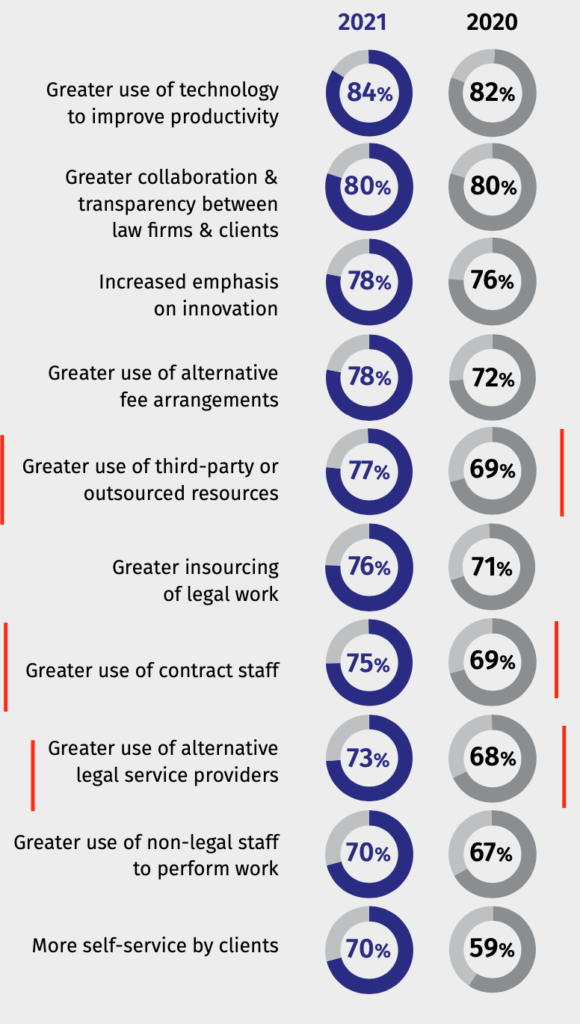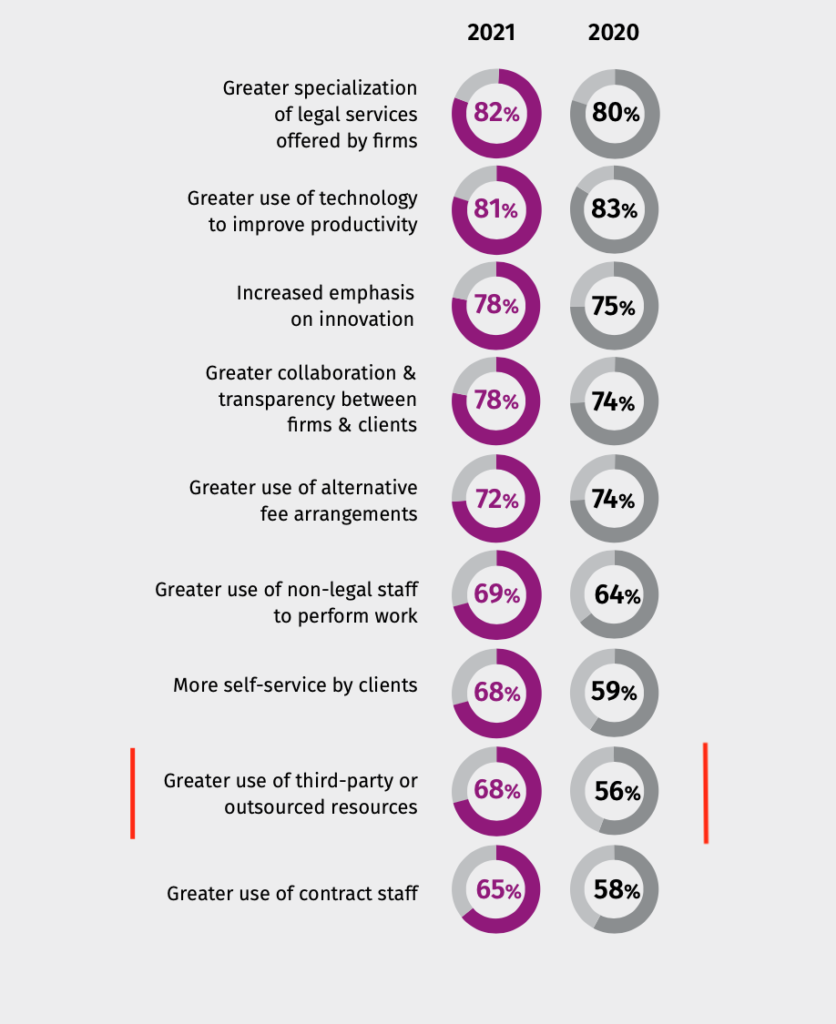
Data collected about demand for ALSPs by Wolters Kluwer underlines just how far they are winning the argument over using non-traditional structures to achieve efficiency, leading this site to consider that we are seeing a clear separation in the means of production now that we can call the Great Legal Bifurcation.
Both for law firms and inhouse teams there was a clear demand for ‘outsourced resources’ and/or explicitly for ALSPs. The two tables below show what they most expected to see change in terms of their needs:


Now, how people describe an ALSP remains open to debate, but the simple version is anything that provides legal services that is not a ‘traditional law firm’ – e.g. reviewing documents for transactions or eDiscovery, or negotiating contracts.
But, ALSPs can also provide ‘lawyers on demand’ services, and other flexible resourcing options. Some, such as Elevate, for example, also offer tech consulting, among other things.
Why is this happening now? Especially when many large commercial law firms are actually doing very well – (although not all).
One reason is the point Artificial Lawyer’s founder made at the end of this Wolters Kluwer report, which included a range of views on the market:
‘The real challenge is … the bifurcation of legal work between complex high value/high risk matters and BAU/repeatable work. While clients have been willing to pay whatever the law firms demanded for emergency work, the reality is that as CFOs push for greater control over legal spending on BAU work, in-house legal teams have a huge opportunity to make a clean break with the past and embrace a ‘new means of legal production’ – tapping technology at scale, better use of process analysis and management, and greater use of specialised legal talent, i.e. not always looking for hourly-based law firm lawyers to do that standard work.’
Law firms may be generating more profits than ever before on complex advisory work, but the pressure on process work pricing has never been greater at the same time. This is more than a small trend now, this has reached a true systemic branching in the market, which this site is now calling: The Great Legal Bifurcation.
Naturally it bodes well for the future of ALSPs (AKA law companies, or this site’s preferred term ‘legal process providers’). The fact that some law firms have built their own process groups, and that the Big Four are ramping up their own, is just more evidence of this Great Legal Bifurcation.
Of course, this self-enforcing and systemic division in legal production methods has been a long time coming, and this week’s data only underlines a story we have seen emerging for some years. But now, it just feels more ‘in your face’ and urgent.
Also, it is all the more significant because many large firms are doing so well. I.e. one might assume that when firms are doing great it’s because they are Hoovering up every piece of work their client base has to offer. But they are clearly not doing this – and as the data shows, increasingly they need external input, and that means fees going beyond the partners’ reach.
(And yet, many firms’ partners are making more $$$ than ever before….so if ALSPs are hitting law firm owners in the pocket, it’s hard to see where in many cases….and perhaps that’s another reason why they are taking off, i.e. they are now part of the system that supports higher partner profits?)
Also, as more and more inhouse teams think about tech, they will think about efficiency – as the two are interconnected like two sides of the same coin.
If you spend a lot of time thinking about efficiency then you may well consider the human input as well in the same terms, e.g. do we have the right capabilities to do this work in the most economical and timely way?
And for the law firms they may ask: are we wasting our best junior lawyers’ billable time on lower margin work? Or perhaps: how do we keep this major client happy and not annoy them by using our regular associate ranks for work that an ALSP could do far better? After all, as has been explored before – the law firms are increasingly working with ALSPs (and always have) because they need them as much as the clients do.
This site doesn’t see how this trend will do anything other than increase and become more pronounced. And this raises one last question: should law schools start preparing students for careers in ALSPs and not assume that all lawyers will go on to a law firm to provide what is called regulated advice?
—
You can find the full report here.
Useful data! Thanks for sharing.